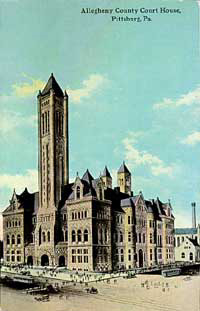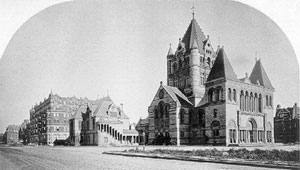The Old Suffolk County Court House and Other Courthouses

The Suffolk County Court House was by far the largest courthouse in Massachusetts when it was completed in 1894. The size was required because, unlike other courthouses across the Commonwealth, this housed the Massachusetts Supreme Judicial Court, the Boston Municipal Court, and the Social Law Library. Architect George Clough's design, however, never influenced any other works because of the unfinished state of his original design, and the awkward addition of the mansard roof in 1909-1910 that transformed the building from German Renaissance style to French Second Empire, a style by then forty years old.[1]
For architectural importance, the Suffolk County Court House paled in comparison to the Allegheny County Courthouse and Jail in Pittsburgh, Pennsylvania constructed a few years earlier.[2] That courthouse was designed by Henry Hobson Richardson, a native of Boston, and one of the nation's leading architects. His designs created the eponymous Richardsonian Romanesque style of architecture which was marked by the use of different shades of granite and sandstone, thick, almost fortress-like walls, round arches and warm, rich colors. Richardson had designed the Hampden County Courthouse in Springfield (1872-1873), but that structure is more of the High Victorian Gothic, and unlike his later creations. It bears little resemblance to his masterpiece, Copley Square's Trinity Church (1872-1877), which is widely considered one of the country's greatest buildings. The Allegheny County Court House, which Richardson thought was one of his greatest works, was commissioned in 1884 and completed after his death in 1888. It's a massive complex of arcades and curved arches featuring a tower and connecting bridge to the jail spanning a city street. Richardson's designs influenced dozens of imitators and admirers who freely combined elements from all his work. The Allegheny Court House was a rare instance where " a county court house was a major event in the history of American architecture!" [3]

The Court House in Pemberton Square never achieved a widely recognizable presence. This can be attributed to a number of factors, including the lack of a nationally prominent architect, a fairly hidden location without any space around it, and other buildings in Boston of national and international stature.
Footnotes:
[1] John C. McConnell, "The Houses of the Law," in GEORGE PEET & GABRIELLE KELLER, COURTHOUSES OF THE COMMONWEALTH 106-107 (1984).
[2] Henry-Russell Hitchcock & William Seale, "Notes on the Architecture," in COURT HOUSE: A PHOTOGRAPHIC DOCUMENT 208-215 (1978).
[3] Id, at 214.